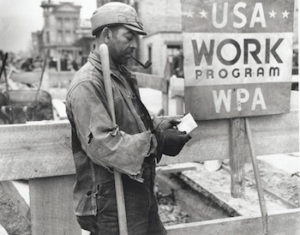
On this date, in 1935, the Works Progress Administration (WPA) was created.
This organization helped provide economic relief to the United States citizens suffering through the Great Depression. Later that summer, it was followed by the Wagner Act, which also influenced labor practice in America. Established by the Roosevelt administration, by the time it ended in February 1943, it had allocated 11 billion dollars and employed more than 8 million people. Jobs formed by the WPA included a variety of construction, clerical, professional, and artistic endeavors. The WPA came at a time of critical need for Blacks. The depression, while imposing hardships on people of all races and ethnic backgrounds, struck Blacks particularly hard.
The WPA hired Blacks, and its projects contributed to their well-being. WPA construction crews built and renovated hospitals, housing projects, schools, parks, playgrounds, and swimming pools in Black communities. Impoverished Black children and adults received free medical and dental care at clinics staffed by Black and white doctors employed by the WPA. Over 5,000 African American instructors and supervisors worked on the WPA’s educational programs. They taught a quarter of a million Black adults to read and write, cutting the illiteracy rate by 5 percent.
An editorial in Opportunity Magazine in 1939 credited the WPA in northern cities with giving qualified Blacks their first chance at employment in white-collar positions. Alain Locke, an early chronicler of the Harlem Renaissance, attributed its survival during the 1930s to the WPA. The WPA also funded Black acting troupes, creating the Federal Theater Project in August 1935. The Negro Theatre Project staged Walk Together Chillun by Frank Wilson at the Lafayette Theatre through the WPA.
The Federal Art Project was one of the divisions of the WPA created under Federal Project One. President Franklin D. Roosevelt had attempted before the Federal Arts Project (FAP). These attempts included the Public Works of Art Project (PWAP), which operated from 1933 to 1934, and the Treasury Department Section of Painting and Sculpture, created in 1934 after the demise of the PWAP. The FAP provided the broadest reach, creating over 5,000 jobs for artists and producing over 225,000 works of art for the American people. Another part of the WPS was its Federal Writers Project and Federal Music Project (FMP). Despite its substantial contributions to the welfare of African Americans, the WPA never fully met the needs of the unemployed, White or Black.
Despite orders from President Roosevelt and WPA directors Harry Hopkins and Aubrey Williams against discrimination “on any grounds whatsoever, such as race, religion, or political affiliation,” unfair practices did occur. The WPA adjusted its wage scales to the prevailing pay rates in the region. Thus, a worker in the South, where about 75% of the Black population lived, received far lower compensation than WPA personnel in the North. Also, African Americans, even in the North, clustered in the least-skilled and poorest-paid positions.
In the New York City WPA in 1937, only 0.5% of its Black employees were supervisors, while 75% were classified as unskilled laborers. Despite many attempts to educate and retain its workers, the WPA never put enough resources into such efforts to upgrade the skills of its common laborers.
To become a construction worker.
The African American Desk Reference
Schomburg Center for Research in Black Culture
Copyright 1999 The Stonesong Press Inc. and
The New York Public Library, John Wiley & Sons, Inc. Pub.
ISBN 0-471-23924-0